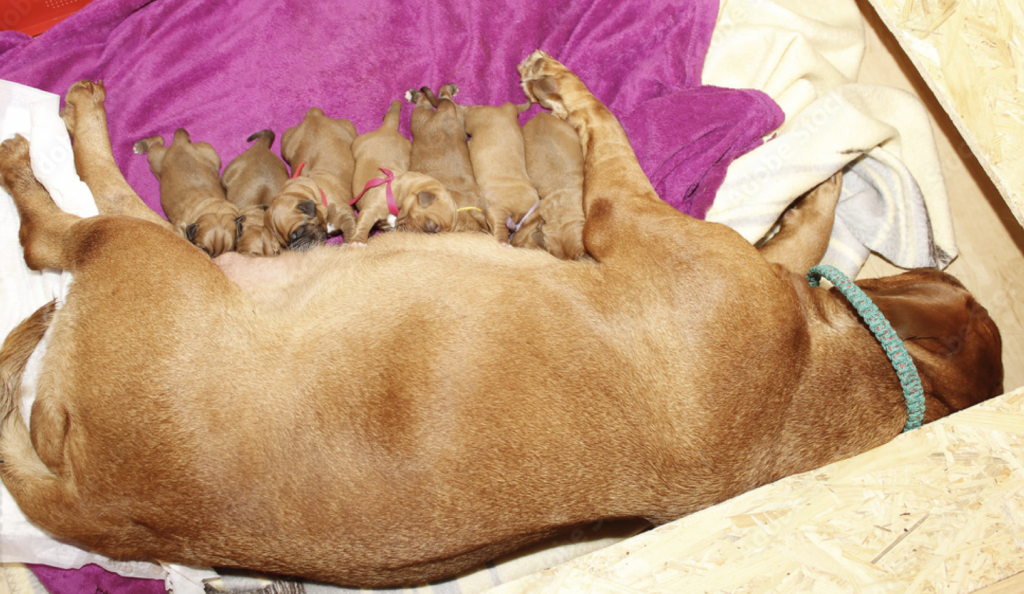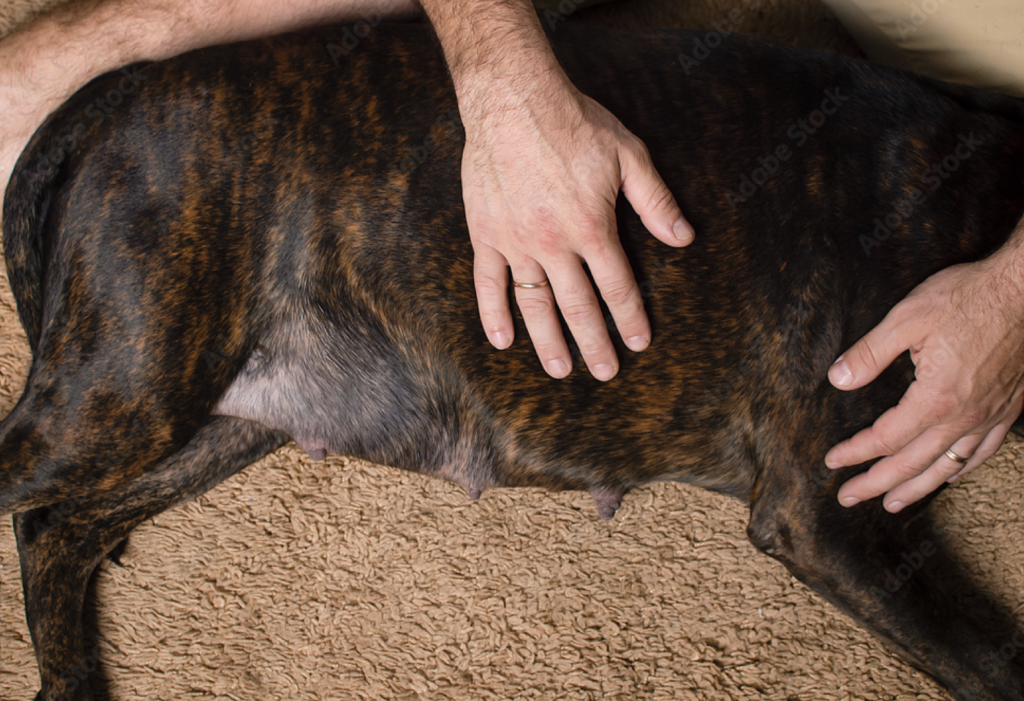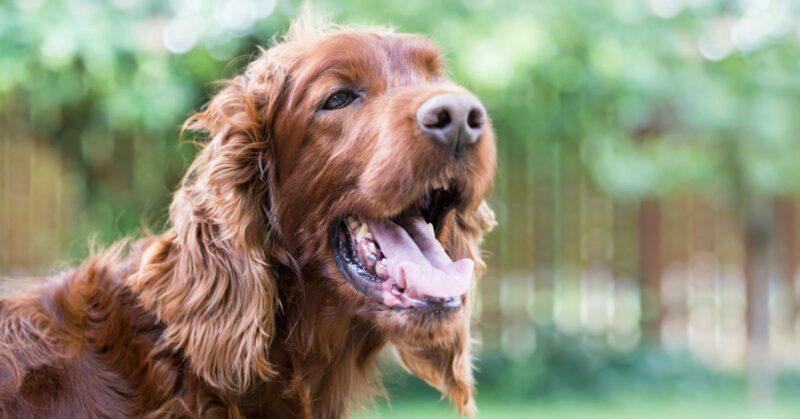
How Long Are Dogs Pregnant?
Whether your dog is pregnant for the first time or you’re waiting for a puppy to arrive from a professional breeder or you’ve adopted a pregnant pup, you may have a lot of questions relating to a dog’s pregnancy.
You might be wondering “How long are dogs pregnant?” A dog’s pregnancy, also known as gestation, typically lasts around 63 days, or about two months, but it can vary between 57 and 65 days depending on the breed and individual dog.
Knowing the length of a dog’s fertility period, recognizing pregnancy signs, and understanding how to assist her during this phase are all vital aspects of canine care. This knowledge is key to ensuring a healthy pregnancy for your dog, leading to a safe delivery.
Pin Me Now, Read Me Later!

When Can Female Dogs Get Pregnant?
A female dog can become pregnant during her heat cycle, which typically lasts for two to three weeks. She’s most fertile during this time period. It’s usually obvious when a dog is entering her heat cycle due to common signs like bloody vaginal discharge, swelling of the vulva, frequent urination, and behavior changes.
If your female dog in heat is around unneutered male dogs and they’re not physically separated, there’s a significant risk of pregnancy. Keeping your female pup in heat away from unneutered males is vital to avoid unwanted litters. There are already many puppies and adult dogs in need of homes.
According to the American Society for the Prevention of Cruelty to Animals (ASPCA), approximately 3.1 million dogs enter US animal shelters every year. Preventing unplanned litters will reduce this number and give the countless dogs in shelters a better chance at finding loving homes.
Charting your dog’s behavior can also help determine her heat cycle and inform breeding decisions. After her cycle ends, consider spaying her to prevent any unplanned pregnancies.
Dog Pregnancy Signs
It can be tricky to detect pregnancy in a dog if you’re unaware of the signs. You can’t exactly buy an at-home pregnancy test and ask your dog to pee on a stick to confirm the pregnancy (but wouldn’t that be convenient?).
If your unspayed female was around an unneutered male dog during her cycle, be on the lookout for the following dog pregnancy signs:
- Change in appetite. Dogs may experience a loss of appetite early in pregnancy and later on may start to eat significantly more than usual.
- Increase in weight. Pregnant dogs will gain weight as the pregnancy proceeds, so sudden weight gain may be an indication.
- Change in behavior. Dogs may become more affectionate or may withdraw and seek solitude.
- Enlargement and discoloration of nipples. This could be an early sign of pregnancy as the dog’s body prepares for nursing puppies.
- Physical changes. Apart from weight gain, a dog’s belly will become noticeably larger around the last weeks of pregnancy.
- Decrease in activity. Due to increased weight and discomfort, a pregnant dog might become less active.
- Nesting behavior. As the delivery nears, pregnant dogs may start gathering blankets or soft items to create a comfortable spot for the birth.
How to Confirm a Dog’s Pregnancy

A veterinarian can confirm your dog’s pregnancy through different tests, which may help determine how many puppies your dog will have and when the conception happened. This will help you calculate when the pups should arrive so you can prepare. Veterinarians usually confirm pregnancies through the following tests:
- Ultrasound to detect heartbeats (as early as 3 weeks post-breeding)
- Hormone tests or relaxin test (as early as 22–27 days into pregnancy)
- Abdominal palpation (between 3 and a half and 5 weeks of pregnancy)
- X-rays (3 weeks before whelping)
How Long Is a Dog’s Gestation Period?
Pregnancy in dogs usually ranges between 57 and 65 days. The typical dog gestation period is measured from the day the dog ovulates to the day she gives birth to her puppies.
Depending on when you discovered your dog was pregnant, this will provide you with somewhere between a few weeks to a month and a half to get her situated and prepare for the puppies.
How to Care for a Pregnant Dog
If your dog’s pregnancy is a surprise and you’ve never been in this situation before, don’t stress! You can do a lot to provide your dog with support and comfort as she goes through pregnancy.
Here’s how you can help your dog during her pregnancy.
Prioritize Proper Nutrition
Ensuring your dog gets the right nutrition is crucial during her pregnancy. Increase her intake of a balanced, high-quality dog food, preferably a formula designed for pregnant or nursing dogs.
However, always consult with your veterinarian before altering your dog’s diet or adding supplements. Remember, as she gets nearer to delivery, her appetite may increase; feed her smaller meals more frequently to avoid overloading her stomach.
See a Veterinarian Regularly
Regular veterinary visits are vital when your dog is pregnant. Your veterinarian can monitor the progress of the pregnancy, catch any potential complications early, and provide advice tailored to your dog’s specific needs.
They may conduct ultrasounds, X-rays, or blood tests to ensure both your dog and her puppies are healthy. Your vet can also provide advice on what to expect during labor and how you can assist.
Keep Her Comfortable
Comfort is key for a pregnant dog. Provide her with a quiet and comfortable space where she can rest as her body changes. As she gets larger, she may need extra help getting around or finding a comfy sleeping position.
Also, ensure she has a safe and cozy area for when she’s ready to nest and have her puppies. Avoid any strenuous exercise and provide gentle pats and massages for comfort. Always check with your veterinarian about suitable ways to keep her comfortable during pregnancy.
Navigating Your Dog’s Pregnancy: One Stage at a Time

You will go through three stages during her pregnancy, similar to the trimesters in a woman’s pregnancy. Here’s what happens during each part of your dog’s pregnancy.
First Month
In the first three weeks, the changes are minimal and might not be obvious in your furry companion. Many pet parents don’t become aware of their dog’s pregnancy until late in the first stage, so don’t feel bad if you miss any potential signs. Some signs to watch out for during this stage include the following:
- Laziness or fatigue
- Increase in appetite
- Morning sickness
- Vaginal discharge
- Swollen nipples
Second Month
Much like expectant human moms, pregnant dogs often show more obvious signs of pregnancy in the second stage. They may gain visible weight, and their nipples may become darker and larger as they prepare to feed the puppies.
By the end of the second stage, you may be able to feel the puppies move inside your dog’s abdomen. Most pet parents have realized their dog is pregnant and may take them to the veterinarian to confirm the pregnancy.
Signs to expect during the second stage include the following:
- Noticeable weight gain
- Increase in appetite
- Enlarged abdomen
- Behavioral changes
- Urinating more frequently
As the puppies’ birth gets closer, it’s important to start looking for good homes for them. The sooner you start, the better chance you have of finding responsible families who can care for the puppies. Every puppy deserves a loving and safe home. Look for people who are ready for the responsibility and have a stable place for the puppy. Talk to them about what it means to take care of a dog for his whole life. By doing this early, you help make sure the puppies will always be well cared for and that we have a community of smart, caring dog owners.
Final Days of Pregnancy
The third month of pregnancy is usually just a few days, as your dog nears day 61 to 65 of the gestation period. The fetuses are almost completely developed by day 58 and will begin their descent into the birth canal around this time.
Signs that labor is close in the third month include the following:
- Appetite loss
- Drop in body temperature
- Restlessness, pacing
- Behavioral changes
Once you observe your dog showing these signs, it’s best to prepare yourself for the birth.
A Dog’s Pregnancy: Giving Birth
As your beloved canine approaches the final stretch of pregnancy, you might be eagerly awaiting the birthing process. Here’s an overview of each stage of labor, and what you can expect during each phase.
Stage 1
This stage, characterized by nesting behavior and a decrease in body temperature, can last between 6 and 12 hours. Your dog may appear restless, reposition a lot, pant, refuse to eat, and even vomit. This stage ends when the cervix is fully dilated.
Stage 2
This is when active labor begins, marked by noticeable contractions and visible effort to push the puppies out. This stage can last from a few minutes to several hours, depending on the number of puppies. Typically, a puppy is delivered every 30 to 60 minutes with 10 to 30 minutes of straining between each puppy. You will see a translucent membrane emerge first, which is the amniotic sac.
It’s highly recommended to seek veterinary help if the first puppy isn’t born within 2 hours of your dog starting contractions.
Stage 3
Each third stage occurs concurrently with the second stage, right after each pup is delivered. This is when the placenta (often referred to as the “afterbirth”) is expelled. It’s usually expelled 5–15 minutes after a puppy is delivered.
How to Support Your Female Dog during Labor

If you want to help your dog during labor, here are some safe and useful things you can do:
Notify Your Veterinarian
Let your veterinarian know when your dog starts labor. Make sure you have a plan for any emergencies or if something doesn’t seem right. Your veterinarian should be easy to reach in person or by phone so you can get advice when you need it.
Create a Safe, Quiet Environment
Your dog needs a safe place to comfortably give birth. It should be quiet and stress-free so she can be as relaxed as possible as she goes into labor and delivers her puppies. Ensure the box where the puppies are kept maintains a temperature of 85°F to 90°F during the first four days. The puppies will need a boost of warmth because they can’t create their own body heat for the first few weeks.
Stay Calm and Monitor from Afar
Dogs instinctively know how to handle birth. Although you’ll want to support her, it’s best to keep a quiet distance and avoid intervening unless there’s a clear need for medical help. Keeping the environment calm and stress-free for your dog helps the birthing process.
The Final Woof on a Dog’s Pregnancy
Discovering your dog is pregnant can bring on a whirlwind of emotions. You’ll have to quickly make plans, contact the veterinarian, and arrange a space for your dog to rest. But otherwise, you can go on as usual, spoiling your pooch and letting her know how loved she is.
As cute as puppies are, however, it’s essential to consider the long-term health and well-being of your dog post-pregnancy. Spaying your dog after she has puppies offers multiple benefits. Not only does it prevent future unintended litters (there are already too many homeless dogs as it is), but spaying can also reduce the risk of certain cancers, infections, and aggressive behaviors. By choosing to spay, you’re taking a proactive step towards ensuring your dog remains by your side, healthy and happy, for many years to come.







Comments (0)